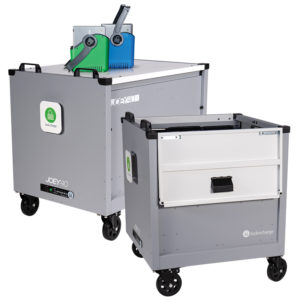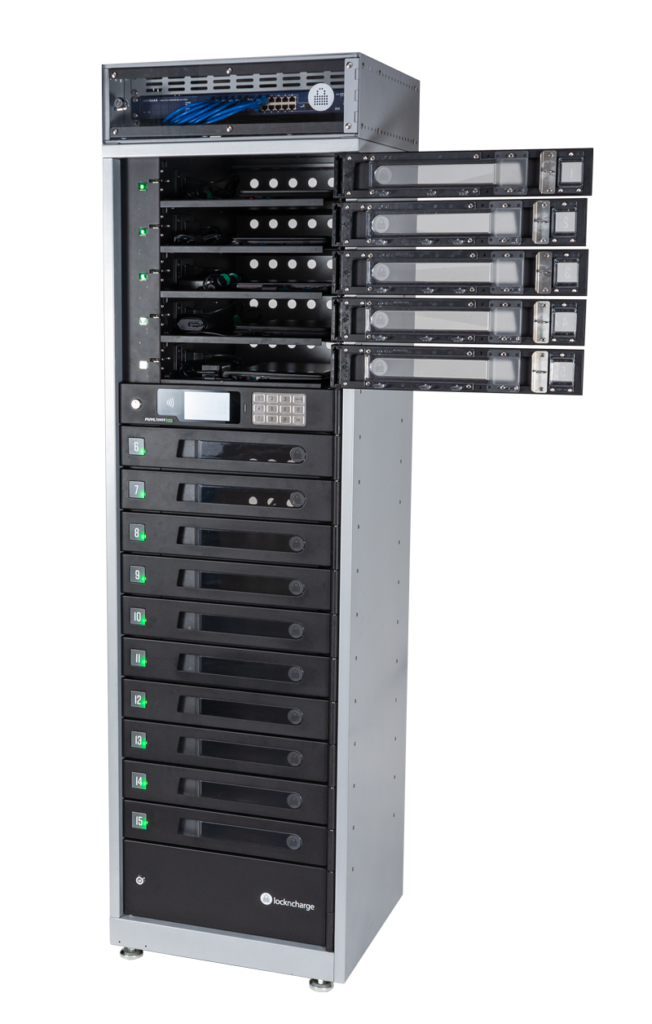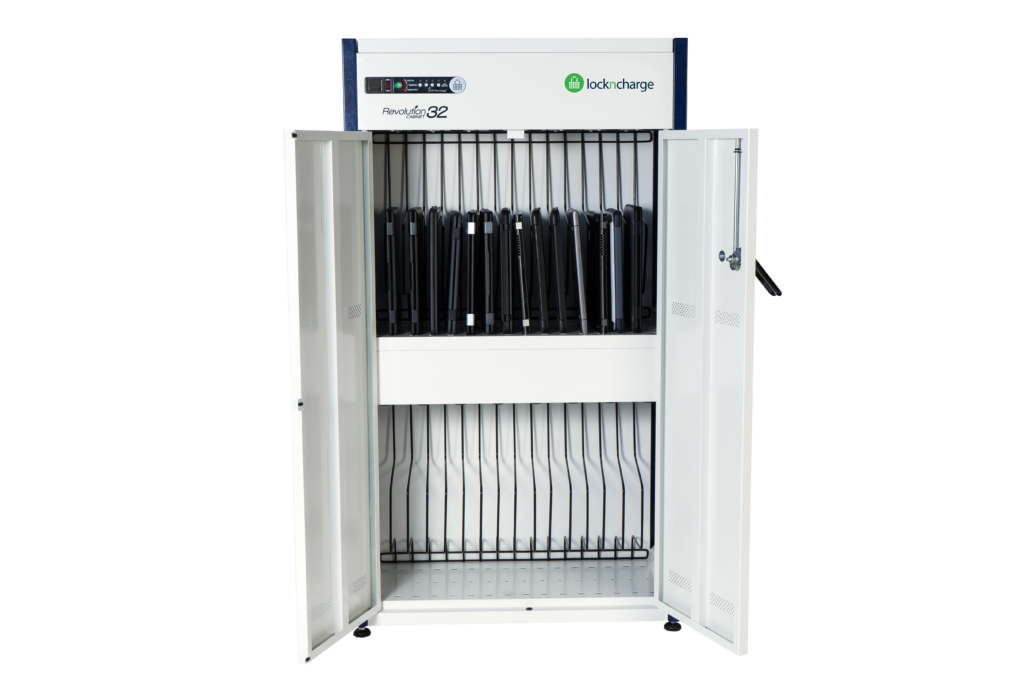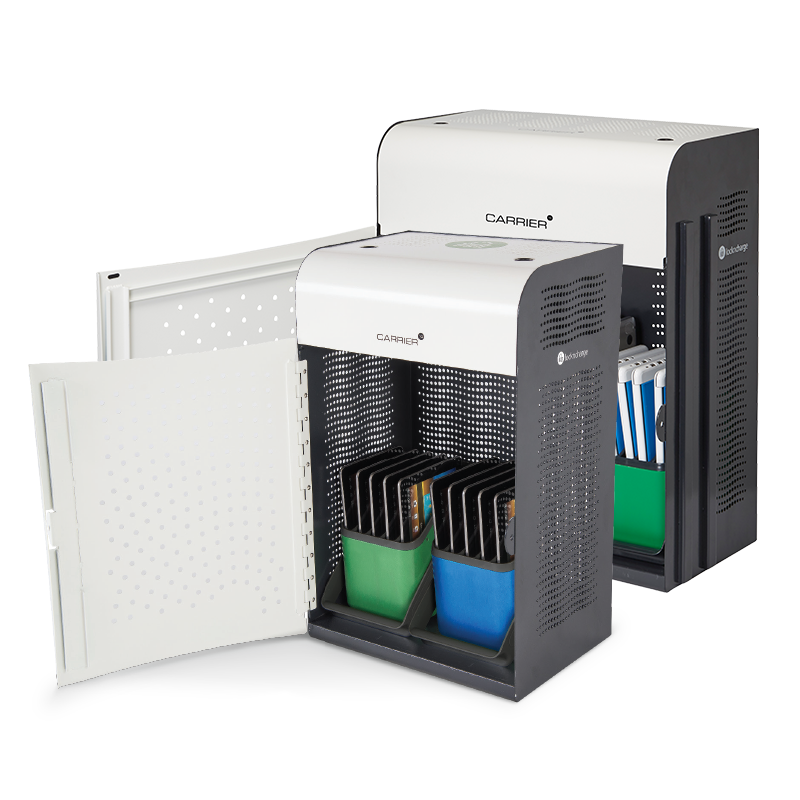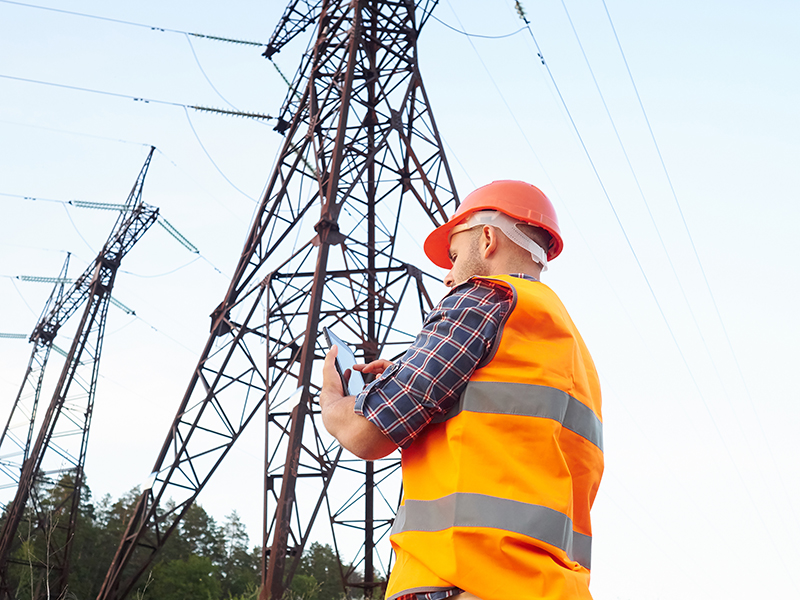The Best Charging Stations for Multiple Devices
At LocknCharge, we are dedicated to designing and manufacturing the highest quality charging stations for multiple devices for any mobile device program.
Our mission is to make life easier for schools and organizations implementing mobile device technology for multiple devices–including tablets, laptops, iPads and MacBook devices. If your school or organization has a number of devices to maintain and manage, you know how difficult it can be to find a charging solution or management system that works.
Cords can get tangled, devices become lost or stolen, a limited number of outlets can lead to a counterintuitive technology plan and device management for broken devices is compounding. With 73% of businesses failing to find a proper charging station for their technology, these problems are more common than you may think!
Best Multiple Device Charging Stations
We’ve rounded up some of our best charging stations, smart lockers and charging carts to meet the needs of multiple device types.
1. Joey Charging Carts
Affordability meets functionality.
Our Joey Carts are an affordable option for any school or business looking to charge multiple devices. The design of this Cart accommodates both racks and Baskets so you can charge up to 30 or 40 of just about any device with a 17” screen size.
Not only is the cart small and compact in size, but it also takes only minutes to wire the entire Cart. Plus the power strips are now more easily accessible, so you no longer have to wrestle with tangled cords. There’s plenty to love about this cart! Check it out here.
2. FUYL Smart Locker System
The FUYL Smart Locker System takes hardware asset management to the next level.
The FUYL Smart Charging Locker System is an Intelligent Hardware Asset Management System that charges, stores, secures and manages assets for most mobile devices in 15 individually-lockable compartments. FUYL Towers are powered by LocknCharge Cloud to remotely manage physical assets secured inside the Tower.
This smart charging locker has 5 or 15 individually-lockable compartments, each equipped with a power outlet and a 2.4 amp USB port. You can manage almost any device, including iPads, tablets, laptops, mobile phones, Chromebooks and more. Learn more about the FUYL Smart Locker System here.
3. Carrier Charging Carts
Carrier 20, 30 and 40 Carts provide ultimate security and durability.
Secure, efficient and a future-proofed, Carrier 20, 30 and 40 Carts sound almost too good to be true, right? Well, these Carts live up to the task. With the option for either racks or baskets, Carrier Carts accommodate almost any device up to 17”. Remove the racks or baskets to create an open-concept design that can also hold other technology such as robotics, printers, drones and more.
Our Baskets by LocknCharge hold five devices and make device deployment quick and easy. The top-loading design ensures easy access to devices–no more bending down to gather devices on a bottom shelf. And with cabling stored in the bottom of the Cart, power bricks and cords stay organized and will never go missing. Learn more about Carrier Carts here.
4. Revolution 32 Charging Cabinet
Charge a greater number of devices in a small footprint.
This charging cabinet can accommodate 32 devices up to 17 inches, with or without a case while taking up 50% less floor space than a traditional charging cart.
For 1:1 classrooms that are tight on space but need to charge, store and secure a greater amount of devices, the Revolution 32 Charging Cabinet is just the ticket. And with ECO Safe Charge Power Management, you can easily charge 32 devices in the same amount of time as just one. Learn more here.
5. Carrier Charging Stations
Carrying you to better charging solutions, one station at a time.
Limited on space? No worries - with our Carrier Charging Stations, you can make any wall or desk a secure charging station for anywhere from 10 to 15 devices.
This charging station for multiple devices also comes equipped with Baskets, making deployment of devices up to 13” faster and easier. And for devices up to 17”, swap the Baskets for Racks to easily accommodate larger devices. Still not convinced? Charge your devices while they’re safely locked, giving you back classroom and work time. Check out the station here.
Short-Staffed Hospitals Gain Efficiency with Device Management
Short-Staffed Hospitals Can Ease the Burden on Nurses with Better Device Management.
There’s no question the vital role healthcare and aged care workers played in combating the effects of the COVID-19 pandemic – and technology was essential in helping them do it. The rapid adoption of digital tech like tablets on an unprecedented scale allowed nurses and practitioners to provide care quickly, minimizing health risks while maximizing responsiveness.
While the World Health Organisation recently declared that the end of the pandemic is in sight, the healthcare sector is now facing another challenge: healthcare and nursing home facilities are struggling with widespread staffing shortages as burnout and turnover accelerate. With the digital transformation of healthcare, careful attention should be paid to optimizing shared device management to continue to meet care standards while easing the burden on an already stressed workforce.
Digital Technology in Healthcare
The use of digital technology in the health sector isn’t new, but the COVID-19 pandemic pushed it to new heights. As patient numbers surged in hospitals and healthcare facilities, portable tech quickly became an essential part of care. Tablets replaced clipboards and connected patients to their families, while management apps tracked crucial health data.
Healthcare services in Victoria, Australia which rapidly pivoted to using virtual care tools, saw positive increases in efficiency and patient experience according to one study, while in New South Wales, the Ministry of Health bought thousands of iPads to monitor patients remotely.
As facilities now look to refine their digital strategies for the post-pandemic age, they also have to contend with healthcare workers around the world experiencing a “pandemic-fueled burnout” severely impacting an ongoing skills shortage. The nursing workforce in the United States is projected to face a shortage of up to 10-20% or 200k-450k by 2025, putting the future of delivering quality healthcare at risk.
A Better Way to Manage Devices in Hospitals, Clinics and Nursing Homes
One way to ease the burden is to streamline the charging and deployment of portable tablets. Compatible with iPads and tablets, LocknCharge Charging Stations for healthcare are designed for fast-paced and shift worker environments.
LocknCharge's Putnam Charging Stations can charge, store, and secure iPad and Tablet devices. They come pre-wired with neatly-organized cables, allowing for easy device retrieval. Streamlining workflow reduces friction during shift rotations and the integrated combination lock gives the entire staffing team access to devices. Placed at nursing stations and check-in desks, the charging stations are ideal for shared devices that need to be charged and accessible at all times.
As technology continues to be critical to modern care, ensuring its ease of use in fatigued and short-staffed medical settings is essential to the future well-being of both staff and patients.
Schedule a Live Product Demo
Schedule a live video demo with a LocknCharge team member to get a closer look at how our products help make your life easier.
10 Tips for Maximizing your School’s Time and Tech Budget in 2023
The Current State of Education
Educators are still reeling from the impact of the pandemic, and staffing shortages in schools are causing disruptions to the education sector throughout the world. In the UK, trainee recruitment was reported to be down by 25,000 compared to 2021. In Australia there is an ‘exodus’ from the profession. While in the US, some districts are reporting ‘catastrophic’ teacher shortages. This shortage places greater reliance on retained teaching staff as well as technology to keep the curriculum on track.
Spending on educational technology increased significantly during the epidemic. Estimates suggest spending in the US could have peaked at as much as $56 billion, but in an economic climate of rising inflation and interest rates, budgets are almost certainly going to shrink.
This poses two significant questions for school administrators:
1. How to manage a shrinking tech budget when schools have become dependent on the solutions tech provides.
2. How to improve processes and find inefficiencies in your tech stack when time and attention is consumed by “keeping the boat afloat”.
In an environment where time has become an equally scarce resource to funding, small improvements to process or resource allocation can often make a big impact.
For over 20 years, LocknCharge has listened to and come to understand many of the challenges that educators, tech teams and administrators are facing when implementing or managing technology in their schools. We have aggregated 10 ideas – derived from our conversations with customers, partners, resellers, edtech software and hardware companies and countless others – to help you make the most of your limited time and technology budget.
Top 10 tips to help make the most of limited time and technology budget
1. Let credible organizations vet your education tech for you.
What could be better than taking the time and legwork out of evaluating edtech solutions? Leveraging experienced professionals to do it for you. The team behind Edtech Evidence Exchange is made up of non-affiliated ex-teachers and researchers who document insights that help PK-12 classrooms uncover which edtech tools are working and why.
Their research shows: “Educators estimate that 85% of edtech tools are poor fits or poorly implemented.” Which is why they support decision makers and offer a variety of services to help educators make better-informed choices – which leads to a better use of resources.
2. Start a student-led help desk.
Starting a student-led help desk is a win-win for students and schools. These programs encourage students to engage with the software and hardware they are using to learn but from an IT perspective. The result is that the school benefits from a cost-effective, home-grown IT resource, the student is empowered to nurture an interest that could develop into a future career, and the IT industry develops a pipeline of potential talent.
Dell Technologies is investing in the Dell Student TechCrew program which supports schools with their student-led help desk initiative. As part of this program, some schools are also implementing Smart Lockers as a total device management solution for tech teams in schools. Smart Lockers offer students the opportunity to write webhooks, software integrations and more – while providing a better way to get devices into the hands of end users.
3. Use other schools as a resource.
Engaging with schools that share the same challenges around resource allocation, tech investments and hardware/software management can often provide a shortcut to finding the best tech solutions. Sharing experiences and effective outcomes is a free resource which comes with the added benefits of peer endorsement and real-world case studies.
Take note of the edtech tools you’re using, and look for programs or user groups focused on enhancing those resources. For example, Ribblesdale High School the UK is a Microsoft showcase school. They are dedicated to helping other schools around the world maximize Office 365 and the accessibility tools used to support teaching and learning.
4. Leverage relationships with reseller reps and vendors.
When it comes to ground-floor insight, your reseller reps and vendors can offer access to a wider network of both business and IT expertise. They can provide you with connections to schools in their network with similar challenges or to the right partners who have the best solution to your problem. In a competitive marketplace, most vendors will be adding value to their offer by providing supplementary services that complement their products. By using reseller reps and vendors as a resource, educators have access to a broad range of experience with products, support and implementation.
5. Invest in automation.
Automation is not only at the forefront of tech development – but is at the center of saving administrators’ significant time. Consider the incremental benefits automation software can provide for student onboarding, grading, scheduling classes, and much more.
This concept stretches to edtech hardware, too. Imagine onboarding daily substitute teachers with an automated process using smart charging lockers. Student or teacher onboarding throughout the school year can be streamlined in the same fashion.
Or envision an automated broken device exchange program where students can replace their broken device with a loaner in just seconds, without IT oversight.
6. Select flexible, forward-thinking software and hardware.
Administrators take great responsibility for the purchases they make, which is why future-proof technology is central to astute edtech selection. Choosing the right software and hardware can save endless hours and dollars if compatible with systems of the future.
For example, Google classroom can be integrated with free educational apps that extend the platform’s capabilities.
Integrations can also enable cloud-connected hardware solutions such as Smart Lockers to automate mobile device management with the least amount of friction possible – providing time saving for IT teams and devices users alike. With easy-to-use, open API, tech teams can maximize their investments by seamlessly integrating software, such as a help desk ticketing system, to get the most out of each individual component.
7. Outsource IT where it makes sense.
It is not just teaching staff that are at a premium and under time pressure within education settings. IT teams are equally stretched, so considering an outsourced IT capability might make perfect sense. Finding a suitable partner is not as difficult as it may seem – as some resellers offer ‘white glove’ services, making it easier for you to get tech up and running in your schools. This can include imaging devices, cabling carts or stations, hardware installation, asset tagging and more.
Managed Service Providers (MSPs) offer end-to-end implementation services – all under one roof. Consolidating services to one provider brings tech expertise, flexibility, security and crucially – cost efficiencies.
8. Simplify and streamline your device management processes.
A centralized approach to managing devices allows teachers and administration to have confidence that hardware is accessible and ready to go when needed. Laptops and tablets that are updated, charged and securely stored ensure classes run seamlessly, even when a student’s device is forgotten, lost or broken. Loaner devices can be centrally stored and managed inside LocknCharge’s FUYL Tower Smart Lockers powered by LocknCharge Cloud.
Including device management protocol as part of teacher on-boarding ensures students aren’t missing out on lessons simply because they don’t have a working device.
9. Stay ahead of the storm by repurposing already-available resources.
It is difficult to predict adversities such as teacher shortages, but it is almost guaranteed that staffing issues will be a problem during the 2023 academic year.
Using tech to mitigate the impact of these absences maximizes the investment made in the technology. Consolidating lesson plans, onboarding processes and teaching resources onto platforms and apps that can be shared with substitutes – and remotely imaged onto mobile devices – has immediate benefits to staff and students alike.
Remote learning was not the ideal environment for many students, but remote teaching methods that were refined during that time can be transferred to in-person learning. One innovative computing teacher found his recorded lessons created during remote learning work well for cover lessons. Now a cover teacher or sub can keep his students on-track even in his absence.
10. Invest in modernization.
Keeping legacy tech as long as possible may be driven by budget constraint, but the continued use of out-of-date systems requires more time (and money) to keep them viable. For example – shifting from desktop software to subscription-based, cloud software ensures students are working in the most up-to-date programs. Automatic security patches are also critical to keep student data and school networks secure.
As a general rule – modernization of software, hardware and IT infrastructure are key steps in future-proofing a technology strategy.
PD Charging 101 – Everything You Need to Know About PD Charging
Commonly Asked Power Delivery (PD) Questions
Mobile device charging technology has come a long way in the past few years. The PD Charging standard and the Type C connector were developed in tandem with the aim of being as universal as possible, making mobile device charging fast and more efficient. As the experts in physical device management, we've answered some of the most commonly asked questions about PD (Power Delivery) charging to help you better understand what it is, how it works and how it may benefit your organization.
Power Delivery (PD) Charging is the latest mobile device charging standard. It lets us quickly charge larger capacity batteries than we were able to in the past. Phones, tablets and laptops can all use PD Charging.
A USB-C PD Charger can detect the device it’s connected to. If that device supports PD protocol, it will negotiate/communicate between the charger and device, and it will send the right amount of power to provide the fastest charge possible.
Together, PD Charging standard and Type C connector are the dream team! The PD Charging standard and the Type C connector were developed in tandem with the aim being as universal as possible.
Lightning devices like the iPhone 12, iPhone X and various iPads have been PD compatible for some time. Using a PD charger in conjunction with an MFI-certified Type-C to Lightning cable allows for higher current draw and faster charging.
Type C is much more than just a cable connector or a device socket. There’s a standard for the connector and socket, several standards for the charging method and yet more standards for the communication of data. Just because a device has a Type C socket does not necessarily mean it also supports PD or high-speed data.
Voltage is selected by negotiation/communication between the charger and the device.
iPhone 12, iPhone X, iPhone 8/ 8 Plus, iPad Pro, Google Pixel 5, Google Pixel 2, Google Pixel 2 XL, Samsung S20 and Note are just some of the popular devices that use PD. When investing in new hardware it’s important to know your new devices are fully compatible with the supporting hardware.
Varies on a product basis. Check your device for specifics.
This is a broader question than people realize. Your old charger can take a USB-A to Type C cable which can connect to a Type C port on a new device and in some cases, may work. So, if you already have the charger and the cable there’s no harm in trying it out.
But most devices will not charge properly, and some will not charge at all. This is important to remember when investing in new hardware.
The Watt capacity (Wattage) of a charger is the amount of power a charger can supply to a device that requests it. Note it is the devices prerogative to request that charge.
The Wattage of a deceive is the amount of power a device can source from a suitable charger.
There is no danger to either device of charger if the relative wattages do not match.
It is ideal for the device (in terms of charge time) that the charger Wattage matches or exceeds the Wattage of the device.
If the attached device does not support the PD protocol, communication cannot be established. By default, a lower charge rate is used. The short of this being that it may just take longer to charge than normal.
Best Charging Stations with USB-C PD
Best Smart Charging Lockers with USB-C PD
How Mobile Devices Help Field Reps Provide Better Service
You may think of a Field Rep as someone who works for a utility company and comes to your house to service your cable box. However, Field Reps are common in many other industries; think mechanics, roadside vehicle service providers, public transportation agents, logistics operations and quality control/maintenance teams.
When Field Reps carry mobile devices, their lines of information and communication drastically open up in many ways. Mobile devices such as tablets and phones are now affording mobile employees a variety of benefits.
Benefits of Mobile Devices for Field Services
Instant Research and Information
Mobile devices give Field Reps access to a world’s worth of research on the go. They can gain insight into their customers and future leads, reflecting better on their company. Additionally, Field Reps working for organizations like energy companies and cable companies will be able to pull up important customer account information at the drop of a hat. Inventory, warranties, and numerous other documents can be at their fingertips. They won’t need to contact their call center, and their customers won’t need to dredge up paperwork.
Information Gathering
With a mobile device, Field Reps can quickly input or update a customers email address, phone number and other data. This also allows for fast follow-ups. Mobile employees such as roadside vehicle service providers can send a quick email or make a call from a mobile device. As companies grow and start to become more data savvy, Field Reps are gathering more data on their customers every time they meet, which allows companies to provide even better customer service.
Real-time data collection is extremely useful to companies because it provides up-to-date information that can be shared throughout an entire organization in seconds. Energy and utility company reps, for example, are able to record meter readings, upload photos of the assessed damage, etc. effortlessly and seamlessly. Real-time data entry ensures that information is recorded more efficiently and more accurately.
GPS
When mobile devices are equipped with location services, customers can know almost exactly when their Field Rep will show up. The mobile device can send a ping to the customer when the Field Rep is on their way, so they will always feel prepared and have a more accurate time estimate. On the other side, Field Reps will be able to more quickly and accurately find the place they’re going with simple GPS capabilities. Imagine if all quality control and maintenance teams used this method.
Instant, Real-Time Communication
Customers and mobile employees can communicate seamlessly–imagine customers never having to phone into a call center to be connected to their rep. If customers can connect directly with their field rep through text, chat or another messaging service, they will be impressed with their reps’ fast response times.
Tips for Efficiently Managing Mobile Devices for Field Service Reps
When you equip your Field Reps with mobile devices, it’s crucial to keep them secure and charged up. Businesses use LocknCharge charging stations or smart charging lockers to save time and money. Here are some quick tips to optimize efficiency for your field service reps:
Store and charge laptop, tablet or cell phone devices in a centralized location.
Centralized device charging sets your reps up for success by ensuring devices are charged, easy to access and ready for use at all times.
Secure devices when not in use.
Would it surprise you to learn that 41% of data breaches are due to lost or stolen devices? Because critical company and customer data is often stored on employee devices, it's important to keep them physically secure after use. Securing devices also helps reduce device breakage to save organizations money on replacement hardware.
Automate your daily device check in/out process.
Field Reps can check out a charged device at the beginning of a shift, spend the day on service calls using a device, and return the device at the end of the shift. With a Cloud-Connected Smart Locker, all of this can be facilitated without manager oversight.
Hold device users accountable.
A FUYL Tower Charging Locker powered by LocknCharge Cloud helps to ensure devices are cared for during use and properly returned after use. By tracking who accessed a bay and when it was accessed, device users are held to account. Remote visibility into the Cloud portal allows department managers or tech teams to see who took a device, when it was taken and when it was returned.
Ready to find out more?
Drop us a line today for a free quote!
